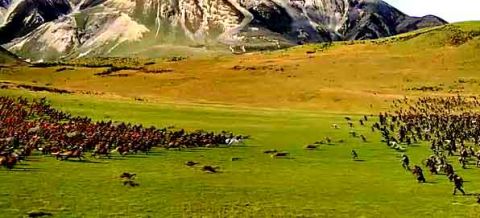
What did the first disciples do on that day? They had made it through the death of their master, slept it off and then woke up in a world without Jesus. It’s a long way to Easter when all you’ve got to get by on is God’s promise. I think C. S. Lewis must have been drawn to the starkness of this experience, feeling instinctively how fitting it is as an image of the Christian life.
One of the most interesting decisions Lewis makes in establishing the chronology of The Lion, the Witch, and the Wardrobe is the way he keeps Aslan out of the picture long enough that the armies of Narnia have to face the White Witch in his absence. The film adaptation handles this very well, I think. Dramatically speaking, it makes for a great story to have the heroes bravely fight against overwhelming odds with no hope of rescue. They give their all and face real martyrdom, before the risen Aslan comes over the hilltop at the last possible second, leading a re-animated army he has gathered from the dungeon of the Witch.
But to pull that off, Lewis has to put the decisive battle into the stretch of time between Aslan’s death and his resurrection. Peter and Edmund and their Narnian forces take their stand in the time between the death and return of Aslan. It’s a bold bit of story-telling, and the only thing that makes it possible is the looseness of the fit between the fairy tale and the reality: if we expected a tighter connection, our imaginations would revolt at the notion of fighting for a dead Jesus, or of comparing the Christian life to a lifetime without Easter. The flexibility of the fairy tale lets Lewis stir in some ingredients which would belong elsewhere in a strict allegory: the general resurrection (breathing on the stone statues), the second coming (Aslan and the warrior saints descending to the battle), and so on.
God forbid that we should live as those who have a savior who has died but has not yet risen. That is surely not Lewis’ point. If Christian existence were stranded on the wrong side of the resurrection, we would be without hope. By putting the warfare of Peter and the church militant into the space of Holy Saturday, Lewis makes the point that we do have hope. Hope, in fact, is precisely what we have. But “hope that is seen is not hope,” and since Jesus ascended into heaven and left us waiting for his return, we are in a position strikingly similar to the disciples: for them, Jesus had descended into the earth and left them waiting for his return. The two returns of Jesus –from the grave and from the Father’s right hand– are different. But the waiting should feel familiar. Welcome to the meantime, where we have God’s promise and live by faith that Christ will be back, keeping all God’s promises. Welcome to Holy Saturday in Narnia.